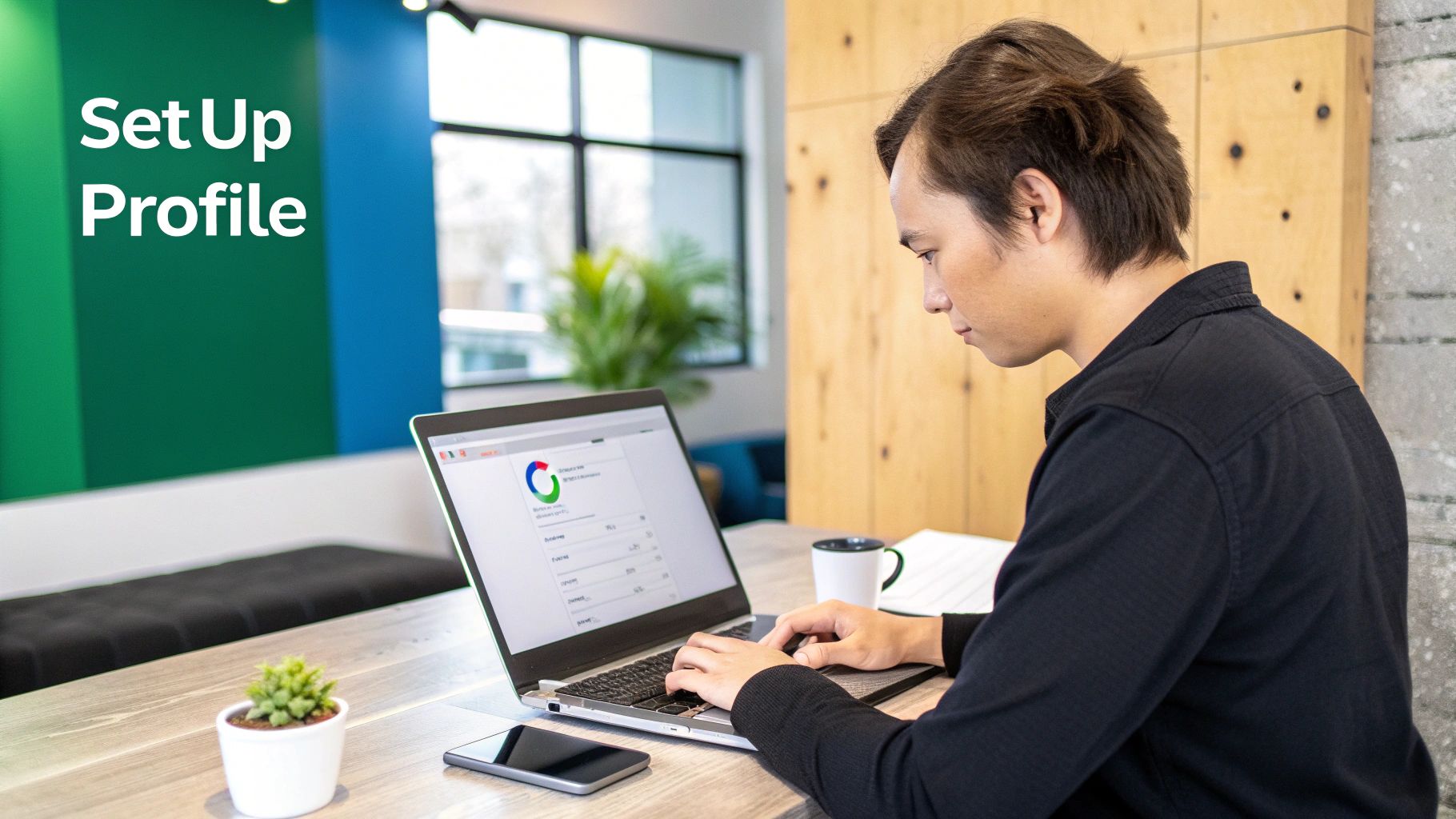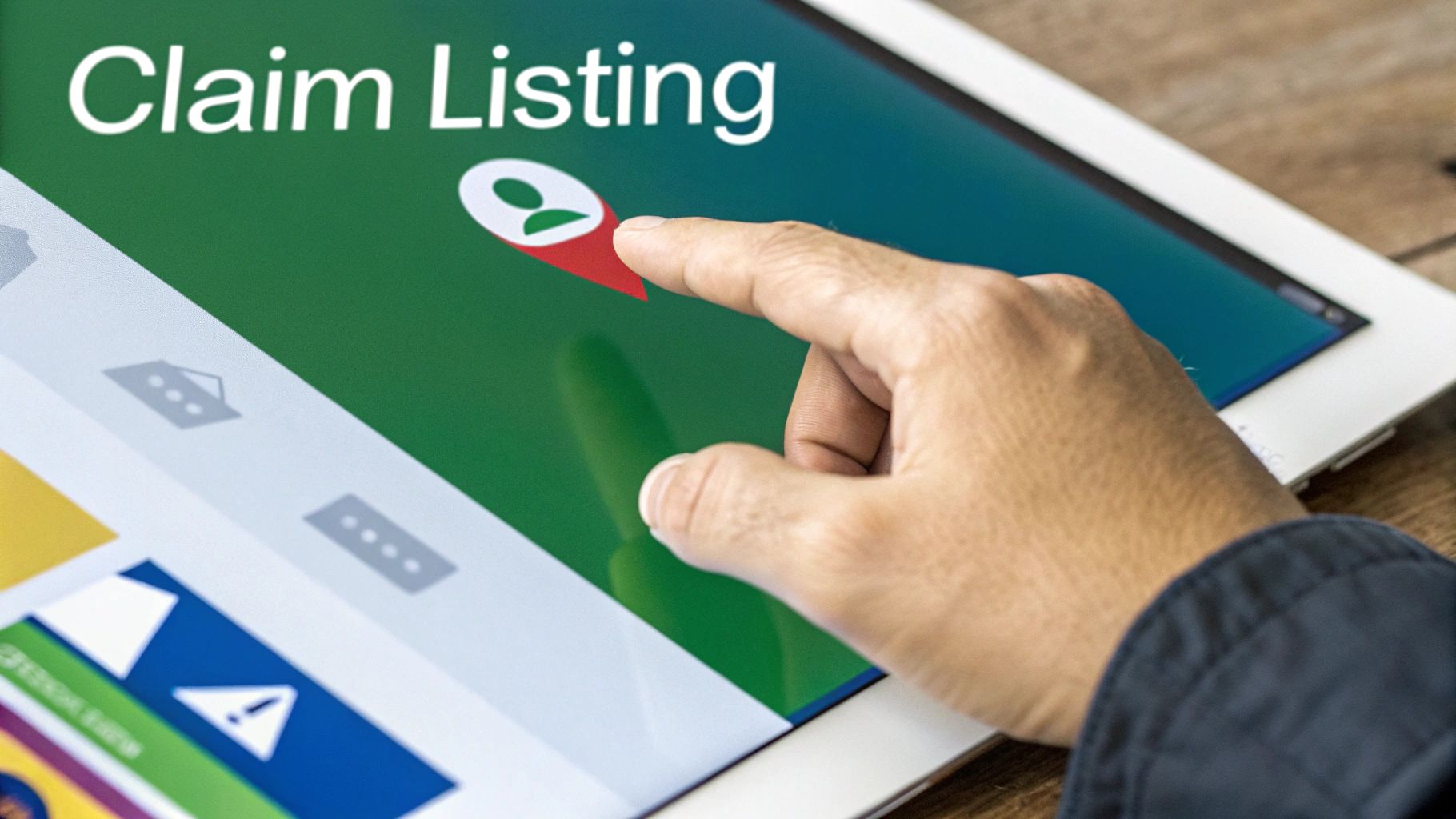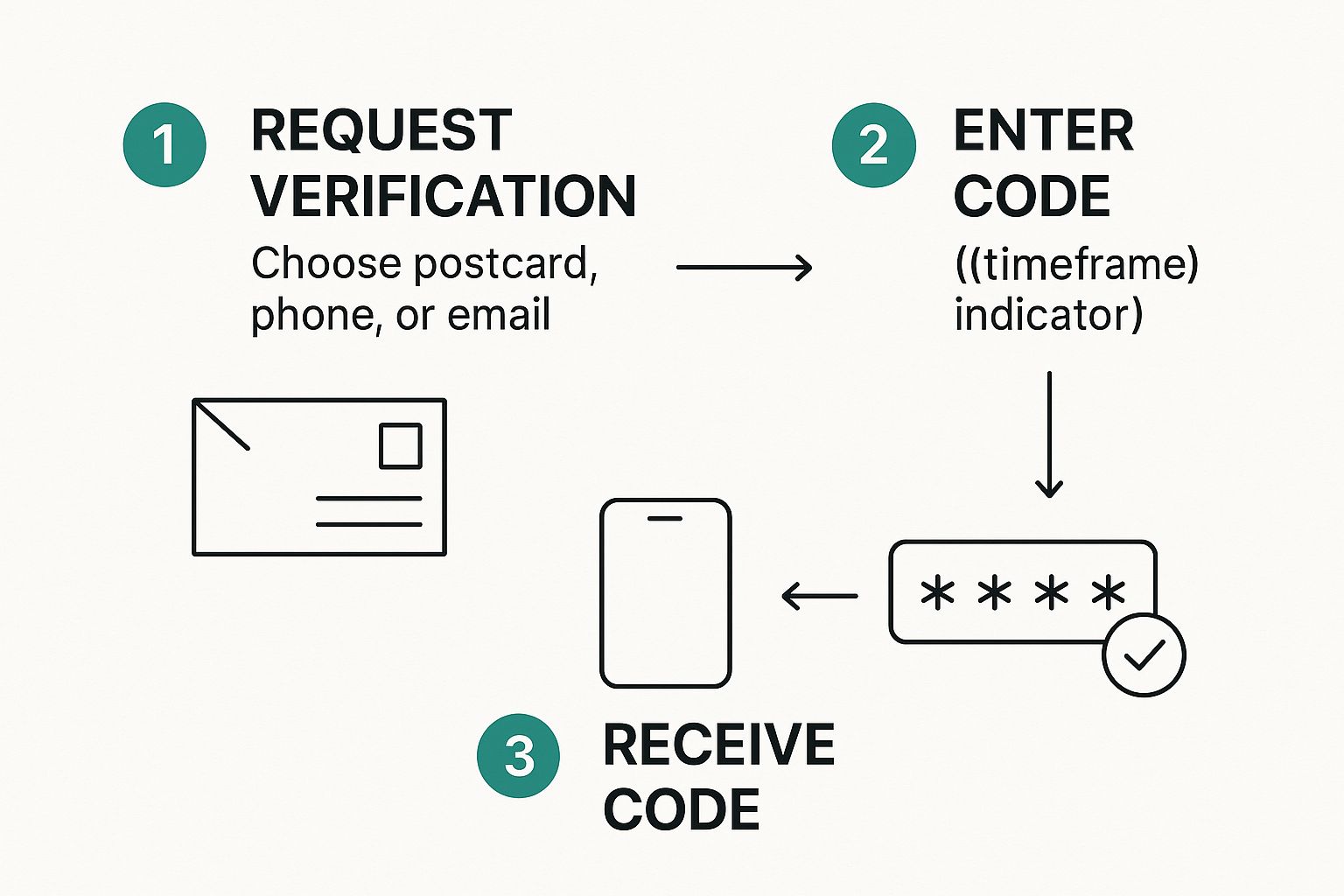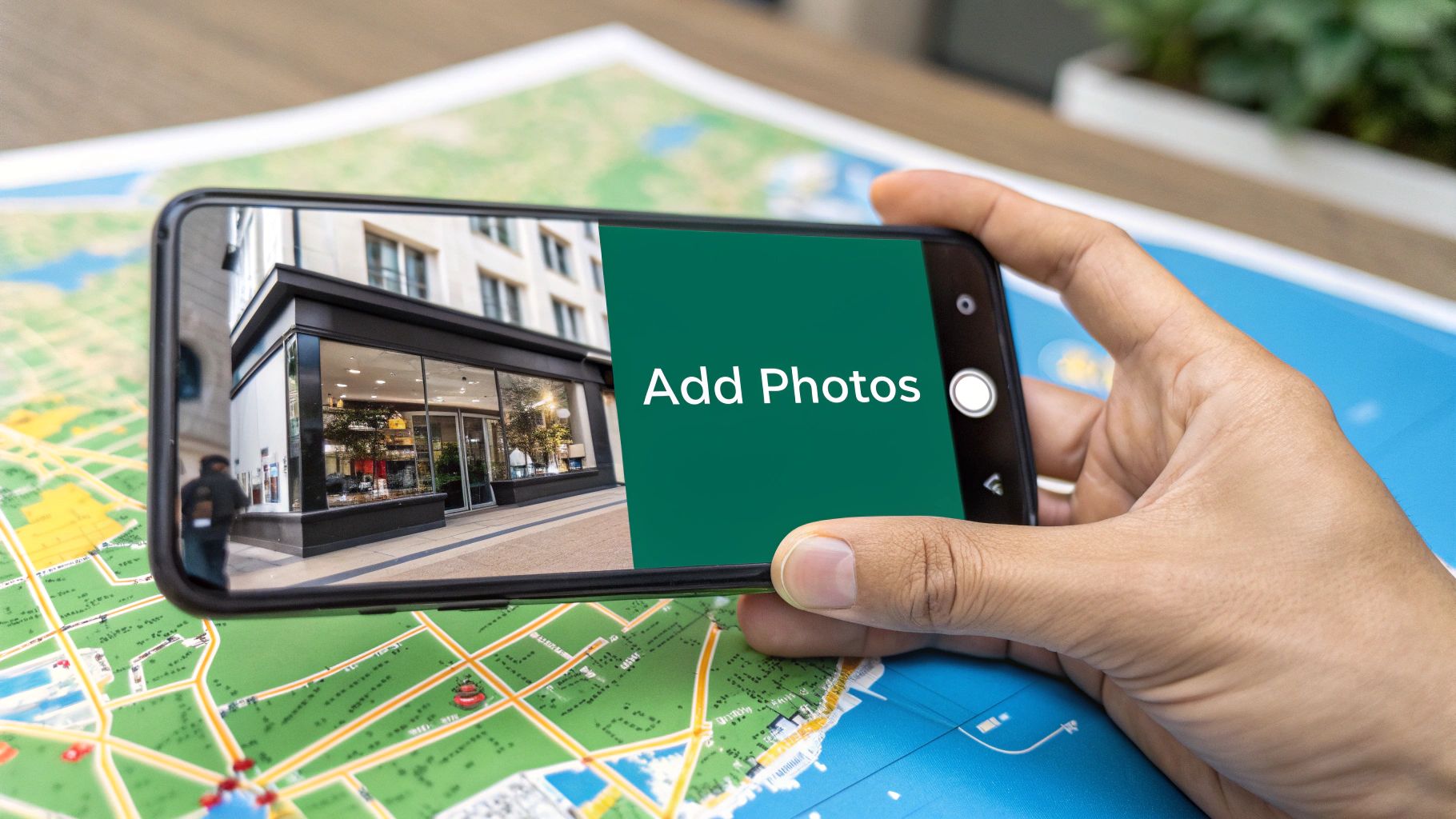How to Get My Business on Google Maps: A Small Business Guide
Learn how to get my business on Google Maps with this simple guide. Boost local visibility and attract more customers today!
Getting your business to show up on Google Maps is one of the most powerful things you can do to find new customers, and it's easier than you think. It all boils down to creating and fine-tuning a free tool called a Google Business Profile. Think of it as your digital storefront—the first thing local customers see when they’re searching for your services.
Why Your Small Business Needs to Be on Google Maps

Let's cut to the chase: if local customers can’t find you on Google Maps, you're handing work to your competitors. For a small business, this isn't just about a pin on a map. It’s your most critical piece of online real estate, putting you directly in front of people actively looking to hire someone right now.
Think about how your customers find help. When a homeowner has a burst pipe or needs a landscaper, they aren't digging out a phone book. They're on their phone, searching "plumber near me" or "gardening services." Google Maps serves up the closest, most relevant, and best-rated businesses first. You absolutely need to be one of them.
The Real-World Impact on Your Business
A solid presence on Google Maps has a direct and measurable effect on your bottom line. It’s the engine that drives genuine leads to your door.
More Phone Calls: Potential customers can tap a button and call you straight from your profile. It's the simplest way for them to get a quote.
More Website Clicks: Your profile links directly to your website, funneling qualified, local traffic right where you want it.
More Foot Traffic: If you have a physical workshop or showroom, it gives people instant directions, leading them right to your door.
This isn’t just a guess; the numbers for Australian businesses back it up. A massive 93% of Australians use Google to find local businesses. On average, a typical business profile drives around 67 customer actions every month—including 36 website clicks and 18 phone calls. These aren’t just browsers; they're warm leads ready to hire.
Your Google Business Profile is far more than a simple listing. It's a powerful customer magnet that proves you're a legitimate business, builds trust with reviews, and gives people the exact details they need to hire you.
Ultimately, mastering your Google Maps presence is a fundamental part of any smart local marketing plan. While it delivers results on its own, it’s even more powerful when it’s part of a bigger picture. For a deeper dive, our guide on SEO for tradesmen shows you how everything connects.
Alright, let's get down to business. This is where you roll up your sleeves and put your business on the map—literally. Getting your business listed on Google starts with creating what's called a Google Business Profile. Don't stress; it’s built for business owners like you, not tech experts. The whole point is to give Google the right details so new customers can find you, trust you, and hire you.
Your first port of call is the official Google Business Profile manager. This is the starting line for getting your business showing up in Google Search and on Google Maps.

The first thing you'll do is type in your business name. Google will check if a listing already exists for you—sometimes one gets created automatically. If it does, you can claim it. If not, you'll create a new one from scratch.
Nailing Your Core Business Details
Getting your basic information right is absolutely crucial. There's no room for error here. Google relies on your core details—what we in the industry call NAP (Name, Address, Phone Number)—to confirm you're a legitimate local business.
Business Name: Use your real, registered business name. It’s tempting to add extra keywords like "Best Plumber Sydney," but don't do it. This is called keyword stuffing, and it's a fast way to get your profile suspended. If your business is called "John's Plumbing," then "John's Plumbing" it is.
Address: This is one of the most important pieces of the puzzle. You need to provide a genuine physical address where you can get mail. A P.O. Box or virtual office won't cut it, and Google will reject it during the verification stage.
Phone Number: List your main business phone number. It has to be a number that a potential customer can actually call to book a job.
Defining How Your Business Operates
Next, Google needs to understand how you do business. This is a critical step because it tells Google how to show your profile to people searching for your services.
Getting this part right from the start is essential. It ensures that customers understand how you operate—whether they can visit you or if you come to them. This choice directly impacts how you appear on Google Maps.
Choosing Your Business Type
You'll have three main options. It's vital to pick the one that truly reflects your day-to-day operations.
Physical Location (Storefront): This is for businesses with a physical shopfront that customers can walk into. Think of a hardware store or a workshop with a public showroom. Your address will be displayed publicly with a pin on the map.
Service-Area Business (SAB): This is the go-to option for most small service businesses. If you're a plumber, electrician, or mobile mechanic, you travel to your customers. For this, you'll enter your home or base address for verification but then—and this is key—you'll select the option to hide your address from the public. Instead of a pin at your address, you’ll define a service area by listing the suburbs or postcodes you cover.
Hybrid Business: This is for businesses that do both. For instance, you might be a carpenter with a workshop customers can visit to see samples, but you also travel to job sites. In this scenario, you list your physical address and define your service areas.
Getting these fundamentals right from the beginning paves the way for a much smoother verification process and saves you from a lot of potential headaches down the track. Once these details are locked in, you're ready for the next step.
Mastering the Google Verification Process
Alright, you’ve put in your business details. Now comes the most critical step: getting verified. This is just Google's way of making sure your business is real and that you’re actually located where you claim to be. It can feel like a bit of a roadblock, but it's a necessary one to protect both you and your potential customers from dodgy operators.
Think of it as the official handshake. Without it, your profile is stuck in digital purgatory, completely invisible to the local customers you’re trying to reach. For most small Aussie businesses, Google has a few different ways to get this done.
The process is pretty simple when you break it down.

As you can see, no matter how you get there, the end goal is always the same: get a unique code, punch it into your profile, and you're officially on the map.
Navigating Your Verification Options
Google will usually show you the verification methods it prefers for your business type and location. You might see just one option, or you could be offered a few.
The most common option, especially for brand new profiles, is verification by postcard. Google will literally mail a postcard to the business address you provided. It typically shows up within 14 days and has a 5-digit verification code on it. Keep an eye out for this—it’s a plain-looking card and many business owners accidentally toss it in the bin thinking it's junk mail.
For some businesses, particularly those that have been around for a while, Google might offer faster options.
Here’s a quick look at the most common ways to get verified and what they involve.
Common Google Verification Methods
Verification Method | How It Works | Best For |
|---|---|---|
Postcard by Mail | Google mails a postcard with a 5-digit code to your physical business address. | New businesses, those without a branded vehicle or physical storefront. The default option for most. |
Phone or Text | An automated call or SMS with the code is sent to your registered business phone number. | Businesses with a listed, established phone number that Google can already associate with the business. |
A verification code is sent to your business email (e.g., [email protected]). | Businesses with an established website and domain-specific email that Google trusts. | |
Video Verification | You show proof of your business (e.g., vehicle, tools, workspace) on a live video call. | Service-area businesses (like mobile trades or consultants) who don't have a public-facing address. |
These different methods ensure that no matter how your business is set up—whether you work from a home office, a workshop, or just your ute—there’s a path to getting your profile live.
Preparing for a Smooth Video Verification
If you get the video verification option, a little bit of prep work will make the whole thing a breeze. Your goal is simply to provide undeniable proof that your business is legitimate.
Have your proof ready before you start the call. This isn't an interrogation; it's just a quick check to confirm you're a real small business. Being organised shows you're professional and speeds everything up.
Here’s a practical checklist of what to have ready to show them:
Proof of Address: A utility bill, lease agreement, or business registration document showing the address you’ve listed.
Your Workspace: Be ready to show your office, workshop, or even the corner of your garage where you run things.
Business Vehicle: A branded car, ute or van is gold. That signage is excellent, hard-to-fake proof.
Tools of the Trade: A quick pan over your tools, equipment, or materials instantly shows you're the real deal.
What to Do If Verification Fails or Is Delayed
Sometimes, things just don't go to plan. The postcard might get lost, or a video call could fail. Don't panic.
If your postcard hasn't turned up after 14 days, you can log back into your profile dashboard and request a new one. If another verification method fails, Google will usually offer an alternative or give you a way to contact their support team. The key here is patience and a bit of persistence—you’ll get there.
Optimising Your Profile to Win More Customers
Getting your business verified is a huge milestone, but it’s really just the starting line. Now, the real work begins. An unoptimised profile is like an empty shop—people might see it, but they have no reason to come inside. Let's turn your basic listing into a powerful magnet for new customers. This is about moving from simply 'being on the map' to actively 'winning on the map'.

This optimisation happens inside your Google Business Profile dashboard. It’s where you add the colour and detail that convince potential customers to pick up the phone and call you instead of the competition.
Craft a Compelling Business Description
Your business description is your 750-character elevator pitch. This is your first chance to tell people who you are, what you do, and why you’re the best choice for the job. You need to go beyond just listing your services. Tell a bit of a story.
Are you a family-owned business with 20 years of experience serving the local area? Say so. That builds instant trust.
Do you specialise in eco-friendly solutions? Absolutely highlight that. It’s a key selling point.
Do you guarantee same-day quotes for all jobs? Make that promise front and centre.
This is your space to connect with customers on a human level. Avoid just stuffing it with keywords; write for the person reading it, and let your personality and professionalism shine through.
Choose the Right Business Categories
This is one of the most important optimisation steps you can take, and it's amazing how many businesses get it wrong. Your primary category tells Google the main thing you do. Be as specific as possible. Don't just pick "Contractor"—choose "Plumber," "Electrician," or "Landscaper."
But don't stop there. Secondary categories are where you can really capture more search traffic by listing all the other services you offer.
For example, a plumber's primary category might be "Plumber," but their secondary categories could include "Hot Water System Supplier," "Drain Cleaning Service," and "Gas Fitter." This simple step helps you show up in searches for all those specific jobs, not just general queries.
Showcase Your Work with High-Quality Photos
Photos build trust and show proof of your workmanship far better than words ever could. A profile with photos looks active and legitimate, while one without looks abandoned or, even worse, untrustworthy.
Aim for a strong start with at least 10 photos when you first set up your profile. For a small business, great photos could include:
Before and After Shots: These are pure gold for showing the quality of your work.
Your Team at Work: Pictures of you or your crew on a job site (with client permission, of course) look authentic and professional.
Your Branded Vehicle and Tools: This shows you're a real, operational business with the right gear.
Your Logo and a Team Photo: Add a personal touch and help customers recognise your brand.
The impact of a complete, well-managed profile is immense. Across Australia and globally, businesses that actively optimise their listings see significant growth. Data shows that verified businesses can get a 70% increase in location requests and a 42% increase in direction taps. Adding elements like photos can boost customer interactions by up to 55%, proving just how much visual proof matters. You can explore more about these trends by reading the full findings on Google Maps engagement.
These simple, actionable steps are how you get your business on Google Maps in a way that actually drives calls, clicks, and customers to your door.
Right, your profile is live, optimised, and actually showing up on the map. That’s a huge win, but if you really want to get a leg up on the local competition, it’s time to start using the tools most of your rivals completely ignore. This is how you move beyond a static, 'set and forget' listing and turn your profile into an active marketing channel that makes it dead simple for customers to hire you.
These features are what separate a good profile from a great one. They signal to potential customers that your business is active, engaged, and ready to get to work.
Use Google Posts to Share Timely Updates
Think of Google Posts as free mini-adverts that pop up right on your profile in search results and on Maps. They're absolutely perfect for sharing timely info that grabs a searcher's attention when they need it most.
You can use them to promote things like:
Special Offers: Got a winter special on hot water system servicing? Create a Post.
New Services: Just started offering 24/7 emergency call-outs? Announce it with a Post.
Recent Projects: Share a great photo of that new deck you just finished, and maybe link back to your project gallery.
Posts typically expire after seven days (unless they're for a specific event), which is a great little nudge to keep your profile fresh. A listing with recent Posts just looks far more current and appealing than one that hasn't been touched in months.
Master the Q&A Feature
The Questions & Answers section on your profile is a goldmine, but you have to manage it. Customers can ask questions directly on your listing, and—here's the scary part—anyone can answer them. If you don't stay on top of this, you could have a well-meaning but completely wrong stranger answering questions on your behalf.
The best way to handle this is to get out in front of it. Think about the most common questions you get over the phone, and then go and add them to your profile yourself, complete with your own clear, expert answers.
By seeding your own Q&A section, you're controlling the conversation right from the start. You’re anticipating what customers need to know, giving them instant answers, and making sure the information they see is 100% accurate.
For instance, a landscaper could pre-load questions like, "Do you offer free quotes?" or "Which suburbs do you service?" This saves everyone a phone call and positions you as a helpful expert.
Encourage and Respond to Every Single Review
Reviews are the lifeblood of your local reputation. You need a simple, repeatable process for asking every happy customer to leave you one. But getting the reviews is only half the job; you absolutely must respond to them.
When you reply, always keep it professional. For a positive review, thank the customer by name and maybe mention a small detail about the job to show you remember them. For a negative review, it's crucial to reply promptly. Acknowledge their frustration without getting defensive, and offer to take the conversation offline to sort things out. This shows everyone reading that you genuinely care about customer satisfaction.
Using these advanced features is fast becoming standard practice for successful Aussie businesses. In fact, over 269,000 Australian websites now embed Google Maps to improve how they interact with customers, showing just how integrated this tool has become. Newer functions like direct booking are closing the gap between a search and a sale, which makes actively managing your profile more critical than ever. You can dig deeper into how Aussie businesses use Google Maps with this detailed resource.
Answering Your Google Maps Questions
Even after walking through all the steps, you've probably still got a few things on your mind. That's perfectly normal. We get these questions all the time from small business owners who are new to the Google Business Profile game, so let's clear them up.
How Long Does It Take to Show Up on Google Maps?
Patience is key here, especially with the first step. Once you’ve built your profile and hit submit, you'll need to verify it. In Australia, Google still loves the good old-fashioned postcard, which usually takes about 14 days to arrive by mail.
After that postcard with its 5-digit code lands in your letterbox, the rest is pretty quick. Punch the code into your dashboard, and your business can appear on Google Maps within hours. Sometimes it might take a day or two for the system to catch up, but it's generally fast. Just remember, getting on the map is different from ranking at the top of the map—that comes from optimising your profile over time.
What If I Run My Business From Home?
This is how most service-based small businesses operate, and Google has you covered. When you set up your profile, you'll need to enter your home address. Don't stress – this is only for Google's eyes and is purely for verification. It will not be public.
During the setup, you’ll tell Google you're a "Service-Area Business". This gives you the option to hide your physical address. Instead of a pin on your house, you’ll define your work area by listing the suburbs or postcodes you service. This ensures you show up for local searches across your entire patch without ever giving away your home address.
The ability to hide your address is a core feature for service businesses. It protects your privacy while making sure you’re visible to potential customers in all the locations you cover. It's the perfect setup for mobile professionals.
Can I Get on Google Maps Without a Physical Address?
No, you absolutely must have a real, physical mailing address where you can receive mail. This is a non-negotiable part of Google's process because they need to send you that verification postcard.
Trying to use a P.O. box or a virtual office is a huge red flag for Google and a surefire way to get your profile suspended. If you work from home, just use your home address for verification and then hide it from your public profile. It's the right way to do it.
Getting your business on Google Maps is a massive first step, but it's one part of a bigger picture. At SiteStarter, we build quality websites for tradies that are designed to turn those Google clicks into paying jobs. We take care of all the tech so you can focus on what you do best. Learn more about how we can help you get found online.